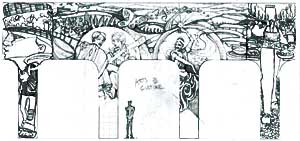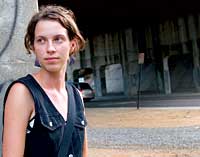About two years ago, Molly Must suddenly realized what was missing from Lexington Avenue—not on the street itself or in its shops, but under the Interstate 240 bridge.

It wasn’t covered in murals.
“This town has such a strong local arts culture, and there’s so much potential in this urban space,” she says. “I was walking under the bridge with a friend … and we were imagining how cool it would be to be surrounded by murals down there.”
So Must, who’s directing Arts2People’s Asheville Mural Project, began planning and put out a call for local artists. The local nonprofit organizes the Lexington Avenue Arts and Fun Festival (see a preview of the festival starting on page 45).
“I started to think about how we could put something there. It’s such a cool space, and it’s so dingy and dark right now,” she says. “We’ve got 11 local artists working on this. … Lexington Avenue is notorious for its interesting characters and is just a really fun place to hang out. I think it could be a little more vibrant with more art on the walls.”
Murals are an art form that’s very much in keeping with Lexington’s unique culture, Arts2People Executive Director Kitty Brown maintains. “This will galvanize [the neighborhood].
“Historically, murals give voice to an under-heard segment of the population, specifically the young and revolutionary,” she notes.

Since the project’s inception, it has had to go through “a bunch of loops,” she says, including getting permission from the city and the state Department of Transportation.
On Aug. 21, however, City Council not only approved the permit but, at the urging of Council member Jan Davis, voted to give the project $6,000. If all goes well, says Must, they should start painting shortly after this year’s festival and finish next spring.
In addition to murals depicting local history and arts and one with a sustainability theme, the insides of the bridge’s arches and columns will feature a gallery of 48 “Asheville saints”—famous figures from the city’s past and present. Arts2People is inviting Ashevilleans to nominate people for inclusion in these murals, she notes.
The whole project, says Brown, will reflect a balance between honoring the past and appreciating future changes.
“The designs do reflect a sense of history and place, but this project came about because all of us working on [it] believe things can be said through art, and change can be galvanized, in a way it can’t through political process,” she explains.
The murals aren’t the only change in the works for the bridge, however. The city plans to pave the surrounding area, which is now used for free parking, and install metered parking spaces.
But Must emphasizes that that’s entirely separate from the murals, something “the city’s been planning for two years,” and she has qualms about it.
“That project has nothing to do with us, but it’s happening at the same time, and I think it might be seen that way,” she notes. “I personally don’t support [installing metered parking]. I hope people won’t see it as us trying to gentrify the area. … We’re not trying to gentrify downtown—we’re trying to make it more vibrant and showcase the unique culture that’s been here for a long time.”
Stephanie Monson, a planner in the city’s Economic Development office, says the city is seeing both projects in the larger context of improving the neighborhood.
“We’re making the parking metered so people will be more encouraged to shop there,” she explains. “That’s what Lexington Avenue’s merchants have requested, along with the improvements we’re making to the sidewalk and to the lamps—we’ve already put in lamps to give it a historic Lexington Park feel.”
Must, meanwhile, observes with a laugh that the only criticism she’s gotten on her project is that “A few times someone’s said, ‘Oh, the graffiti is just getting going there.’ But we’ve got graffiti artists working on this too, and I think it will end up a larger piece of fine art than some of the tags there.” The murals will have a special coating, she says, allowing graffiti to be removed without damaging them.
Arts2People is still seeking artists, adds Must, inviting anyone who’s interested to submit their portfolio. Among the concepts already submitted are stylized depictions of trees, musicians, working-class figures (including a bartender and a cook), and local notables such as Thomas Wolfe and Andie MacDowell
For her part, Brown believes the project will showcase Lexington’s “core principles, which are radical self-expression, community, diversity, sustainability, spirituality.
“Other than the first one, they’re not all that different from anyone else’s values, but that’s kind of the point, isn’t it? People on Lexington Avenue may look a little different, but that’s just the self-expression. Everything else is shared—that’s why they deserve to remain a part of this community.”



There are more photos of the process and the working sketches over at http://ashevillemuralproject.org/ just click on photos / sketches
Hey ya’ll, just to be clear, we’re not painting Thomas Wolfe or Andie Mcdowell. Those ideas were submitted, however we unanimously vetoed them.
what about painting the inside of the tunnel on tunnel road? i’m thinking rainbows or maybe some glow in the dark gritty portraits of miners to celebrate the hard work of the laborers of yore. thinkaboudit!
I think there are alot of places like that around asheville, like the sides of the Chestnut st. bridge by the five points on broardway. or like the person above mentioned, the tunnel on tunnel road.